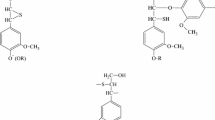Abstract
Precipitated hardwood lignin (PHL) is a major byproduct in the biomassto-ethanol process. Oxidativecracking of PHL by hydrogen peroxide in aqueous medium was investigated as a means to produce potentially useful chemicals. The cracking reaction takes place at moderate temperatures (80–160°C), giving mono-and dicarboxylic acids as the main products. The yields of these products are in the range of 30–50% of initial lignin. The reaction mechanism and the product distribution are dependent upon the reaction conditions, especially the pH. The reaction under strong alkaline condition proceeds well even at low reaction temperatures (80–90°C). Under acidic conditions, higher temperatures (130–160°C) are required to attain the same degrees of cracking. The reaction patterns of the oxidative cracking reaction involve the cleavage of lignin ring, aryl ether bond, or other linkages within lignin. By using the findings of this investigation and those of previous work, we have illustrated the reaction pathways for degradation of PHL under alkaline and acidic conditions. Aldehydes and aromatic acids are interm ediate products in the oxidative degradation of lignin. However, they were produced only in trace amounts owing to rapid degradation induced by hydrogen peroxide.
Similar content being viewed by others
References
Sarkanen, K. V. and Ludwig, C., eds. (1971), Lignins: Occurrence, Formation, Structure and Reactions, Wiley, New York.
Torget, R. W., Nagel N., Jennings, E., Ibsen K., and Elander, R. (1999), 21st Symposium on Biotechnology for Fuels and Chemicals, Fort Collins, CO.
Rydholm, S. A. (1965). Pulping Processes, Interscience, New York, p. 893.
Dence, C. W. (1975), in Chemistry of Delignification with Oxygen, Ozone, and Peroxides, North Carolina State University School of Forest Resources, UNI Publishers, Tokyo, pp. 199–205.
Legrini, O., Oliveros, E., and Braun, A. M. (1993), Chem. Rev. 93, 671–698.
Reichert, J. S., Cambell, D. J., and Mills, R. T. (1944), Tech. Assoc. Papers 27, 364–370.
Brown, D. G., and Abbot, J. (1995), J. Wood Chem. Tech. 15 (1), 85–111.
Overend, R. P. and Chornet, E. (1990), Can. J. Physiol. 68(9), 1105–1111.
Abatzoglou, N., Chornet E., Belkacemi, K., and Overend, R. P. (1992), Chem. Eng. Sci. 47(5), 1109–1122.
Bailey, C. W. and Dence, C. W. (1969), Tappi 52 (3), 491.
Kempf, W. (1975), in Chemistry of Delignification with Oxygen, Ozone, and Peroxides, North Carolina State University School of Forest Resources, UNI Publishers, Tokyo, pp. 207–216.
Levitt, L. S. (1955), J. Org. Chem. 20, 1297.
Ishikawa, H., and Oki T. (1964) Kami-pa Gikyoshi 18(11), 477 Chem. Abstr. 62, 12,010 (1965).
Author information
Authors and Affiliations
Corresponding author
Rights and permissions
About this article
Cite this article
Xiang, Q., Lee, Y.Y. Oxidative cracking of precipitated hardwood lignin by hydrogen peroxide. Appl Biochem Biotechnol 84, 153–162 (2000). https://doi.org/10.1385/ABAB:84-86:1-9:153
Issue Date:
DOI: https://doi.org/10.1385/ABAB:84-86:1-9:153




